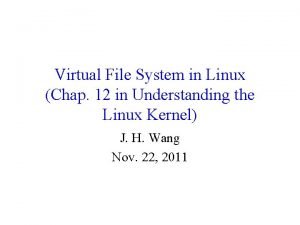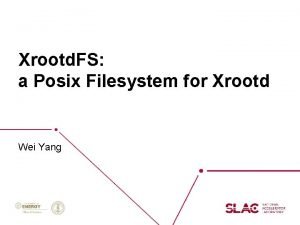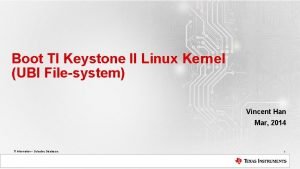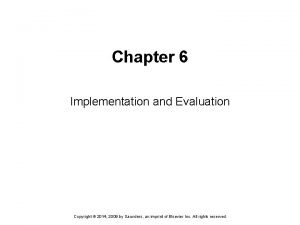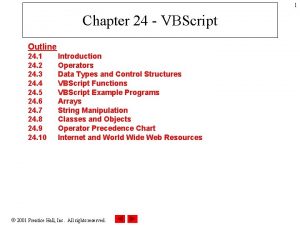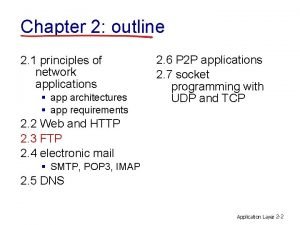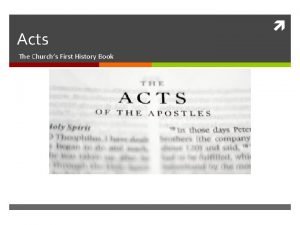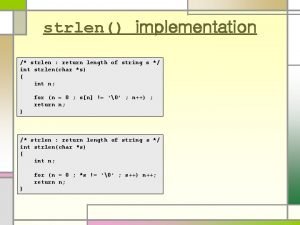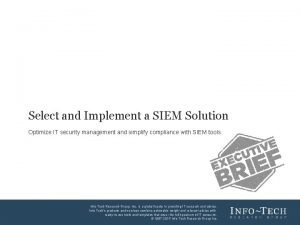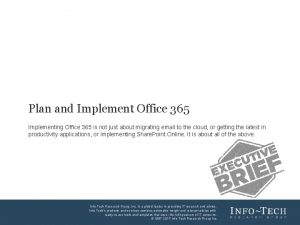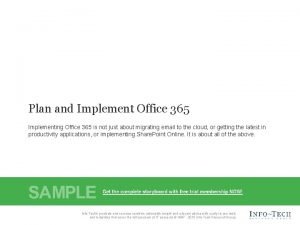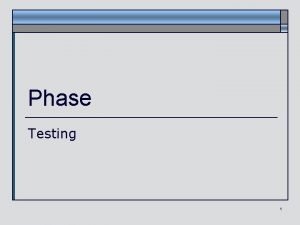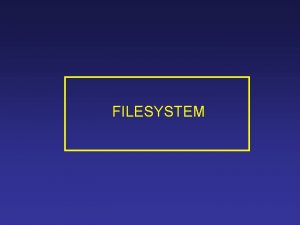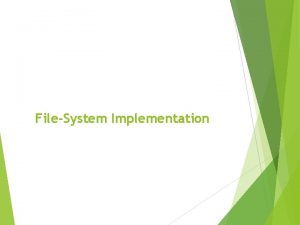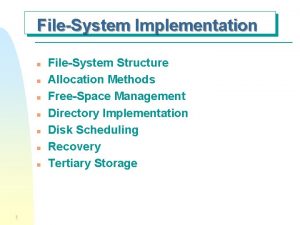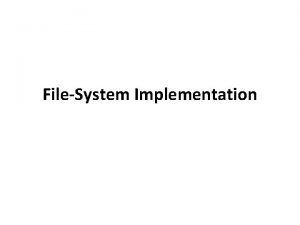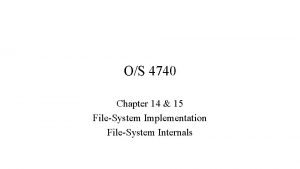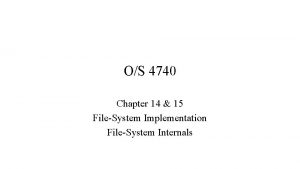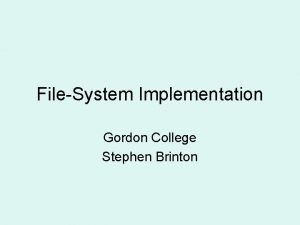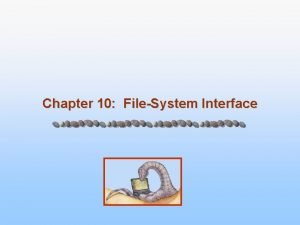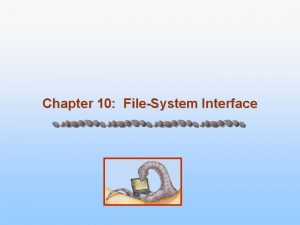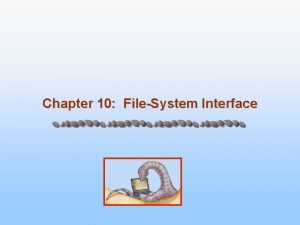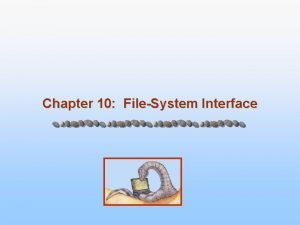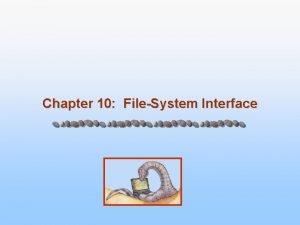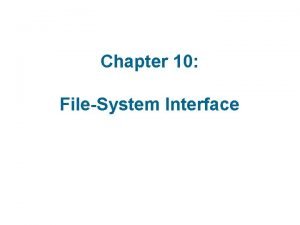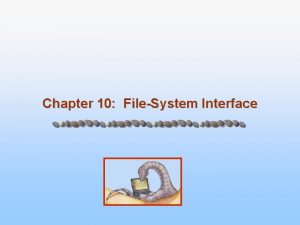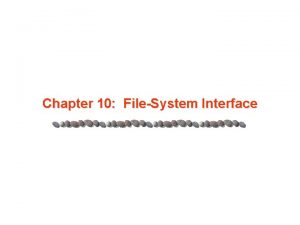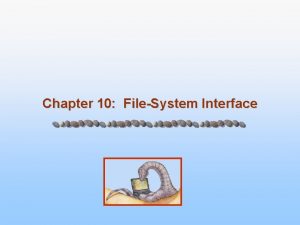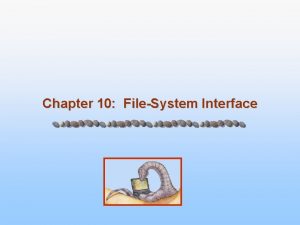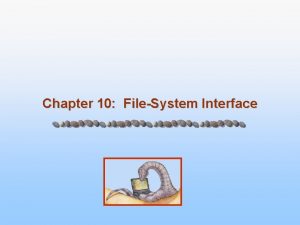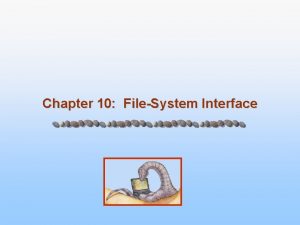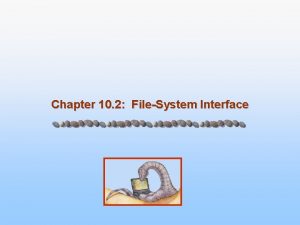Chapter 12 FileSystem Implementation 1 Outline FileSystem Structure






















































- Slides: 54

Chapter 12 File-System Implementation 1

Outline • • • File-System Structure File-System Implementation Directory Implementation Allocation Methods Free-Space Management Efficiency and Performance Recovery Log-Structured File System NFS 2

12. 1 File-System Structure 3

Introduction • File structure – Logical storage unit – Collection of related information • File system resides on secondary storage (disks) • File system organized into layers • File control block – storage structure consisting of information about a file – Ownership, permissions, and location of the file content • I/O transfers between memory and disk are performed in units of blocks (one more sectors) 4

Layered File System 5

Layered File System (Cont. ) • I/O control – device drivers and interrupt handlers – Transfer information between main memory and disk system – Retrieve block 123 HW-specific instructions • Basic file system – Issue generic commands to device driver to read and write physical blocks on the disk – Physical block: drive 1, cylinder 73, track 2, sector 10 6

Layered File System (Cont. ) • File-organization module – Know about files, their logical blocks, and physical blocks – Translate logical blocks to physical blocks (similar to VM) • Logical blocks: 0 – N – Free-space manager – Blocks allocation • Logical file system – manage metadata information – Metadata: file-system structure, excluding the actual file contents – Manage the directory structure via file control blocks (FCB) 7

Layered File System (Cont. ) • Why Layered file system? – – All the advantages of the layered approach File system standard: UFS, FAT 32, NTFS… Duplication of code is minimized for different file system standard Usually I/O control and the basic file system code can be used by multiple file system formats. 8

A Typical FCB 9

12. 2 File System Implementation 10

On-Disk Structures • Boot control block: information needed by the system to boot an OS from that partition – UFS: boot block; NTFS: partition boot sector • Partition control block: partition details – No. of blocks, size of the blocks, free-block count and free-block pointers, free FCB count and FCB pointers – UFS: superblock; NTFS: Master File Table • A directory structure is used to organize the files • File control block: many of the file’s details – File permissions, ownership, size, location of the data blocks – UFS: inode; NTFS: within the Master File Table 11

In-Memory Structures • An in-memory partition table containing information about each mounted partition • An in-memory directory structure that holds the directory information of recently accessed directories • The system-wide open-file table (Chapter 11) • The per-process open-file table (Chapter 11) Caching information so that no need to retrieve the information every time from the disk 12

In-Memory File-System Structures File Open 13 File Read

Virtual File Systems • Virtual File Systems (VFS) provide an object-oriented way of implementing file systems • VFS separates file-system-generic operations from their implementation by defining a clean VFS interface • VFS allows the same system call interface (the API) to be used for different types of file systems • VFS is based on a file-representation structure, called a vnode, that contains a numerical designator for a networkwide unique file • The API is to the VFS interface, rather than any specific type of file system 14

Schematic View of Virtual File System Open, read, write… 15

12. 3 Directory Implementation • Linear list of file names with pointer to the data blocks – Simple to program – Time-consuming to execute – linear search to find a particular entry • Cache and sorted list may help • Hash Table – linear list with hash data structure – Decreases directory search time – Collisions – situations where two file names hash to the same location – Fixed size and the dependence of the hash function on that size 16

12. 4 Allocation Methods How to allocate space to files so that disk space is utilized effectively and files can be accessed quickly 17

Contiguous Allocation • A file occupies a set of contiguous blocks on disk • Only starting block (block #) and length (number of blocks) are required in the directory entry (FCB) • Fast -- Minimal seek time and head movement • Random access any block within the file • Similar to dynamic storage-allocation problem – External fragmentation – may need compaction • Files are difficult to grow – Find a larger hole and copy the file to the new space 18

Contiguous Allocation (Cont. ) 19

Extent-Based Systems • Many newer file systems (I. e. Veritas File System) use a modified contiguous allocation scheme • Extent-based file systems allocate disk blocks in extents • An extent is a contiguous block of disks. Extents are allocated for file allocation. A file consists of one or more extents. • Integrate contiguous allocation and linked allocation (see later) 20

Linked Allocation • Each file is a linked list of disk blocks – Blocks may be scattered anywhere on the disk – Directory contains a pointer to the first and last blocks – Each block contains a pointer to the next block • Advantages – No external fragmentation – Easy to grow – Any free block is OK • Disadvantages – Effectively for only sequential-access file – Space required for the pointers – Reliability – What if the pointers are lost 21

Linked Allocation (Cont. ) block = pointer data 22

Linked Allocation (Cont. ) • Solution for spaces for pointers – Collect blocks into clusters, and allocate the clusters than blocks (每 次Allocate一個Cluster, 而非一個Block) – Fewer disk head seeks and decreases the space needed for block allocation and free-list management – Internal fragmentation • Solution for reliability – Double linked list or store the filename and relative block number in each block • More overhead for each file 23

Linked Allocation (Cont. ) • FAT (File Allocation Table) – OS/2, MS-DOS – The table has one entry for each disk block and is indexed by block number • Similar to the linked list • Contain the block number of the next block in the file – Significant number of disk head seeks • One for FAT, one for data • Improved by caching FAT • Random access time is improved 把Pointer集中放置 於FAT,而不是跟 Data Block放一起 24

Indexed Allocation • Bring all pointers together into the index block – – An array of disk-block addresses The ith entry points to the ith block of the file The directory contains the address of the index block Similar to the paging scheme for memory management 25

Example of Indexed Allocation 26

Indexed Allocation (Cont. ) • Advantage – – Support random access Dynamic access without external fragmentation No size-declaration problem But have overhead of index block. Need index table • Disadvantage – Wasted space: Worse than the linked allocation for small files • How large the index block should be – – Large index block: waste space for small files Small index block: how to handle large files 27

Indexed Allocation (Cont. ) • Mechanism for handling the index block – Linked scheme: Link together several index blocks – Multilevel index: like multi-level paging • With 4096 -byte blocks, we could store 1024 4 -byte pointers in an index block. Two levels of indexes allows 1, 048, 576 data blocks, which allow a file of up to 4 gigabytes – Combined scheme: For example BSD UNIX System 28

Indexed Allocation – Multilevel Index (Cont. ) 29

Combined Scheme: UNIX (4 K bytes per block) The UNIX inode How large can a file be, if each pointer in the index blocks is 4 bytes? 30

12. 5 Free Space Management 31

Bit Vector • Simple and efficient to find the first free block, or consecutive free blocks 0 1 2 n-1 … – By bit-manipulation • Requires extra space – block size = bytes – disk size = 230 bytes – n = 230/212 = 218 bits (or 32 K bytes) 212 bit[i] = 0 block[i] free 1 block[i] occupied 001111100011000011100… • Efficient only when the entire vector is kept in main memory – Write back to the disk occasionally for recovery needs Question: What’s the block # of the fist free block? 32

Linked List • Link together all free blocks • Keep a pointer to the first free block in a special location on the disk and caching it in memory • Cannot get contiguous space easily • No waste of space • Not efficient: have to traverse the disk for free spaces – Usually, OS needs one free block at a time • FAT incorporate the linked list mechanism 33

Grouping And Counting • Grouping: store the address of n free blocks in the first free block. The first n-1 are actually free. The final block contains the addresses of another n free blocks… • Counting: Each entry has a disk address and a count – Several contiguous blocks may be allocated or freed simultaneously 34

Example Of Free-Space Management ØBit Vector 110000001111110001111 ØGrouping Block 2 3, 4, 5 Block 5 8, 9, 10 Block 10 11, 12, 13 Block 13 17, 28, 25 Block 25 26, 27 Ø Counting 2 4 8 6 17 2 25 3 35

12. 6 Efficiency and Performance 36

Efficiency and Performance • Efficiency dependent on – – Disk allocation and directory algorithms Types of data kept in file’s directory entry • Performance – – On-board cache – local memory in disk controller to store entire tracks at a time Disk cache – separate section of main memory for frequently used blocks (LRU is a reasonable algorithm for block replacement) Free-behind and read-ahead – techniques to optimize sequential access (optimize the disk cache’s block replacement algorithm) Improve PC performance by dedicating section of memory as virtual disk, or RAM disk. 37

Various Disk-Caching Locations 38

Page Cache • Non-unified buffer cache – A page caches pages rather than disk blocks using virtual memory techniques – Memory-mapped I/O uses a page cache – Routine I/O through the file system uses the buffer (disk) cache • Unified Buffer Cache – A unified buffer cache uses the same buffer cache to cache both memory-mapped pages and ordinary file system I/O 39

I/O Without/With A Unified Buffer Cache 40

12. 7 Recovery • Consistency checker – compares data in directory structure with data blocks on disk, and tries to fix inconsistencies • Use system programs to back up data from disk to another storage device (floppy disk, magnetic tape) • Recover lost file or disk by restoring data from backup 41

Log Structured File Systems • Log structured (or journaling) file systems record each update to the file system as a transaction • All transactions are written to a log. A transaction is considered committed once it is written to the log • However, the file system may not yet be updated • The transactions in the log are asynchronously written to the file system. When the file system is modified, the transaction is removed from the log • If the file system crashes, all remaining transactions in the log must still be performed 42

12. 9 NFS 43

The Sun Network File System (NFS) • An implementation and a specification of a software system for accessing remote files across LANs (or WANs) • The implementation is part of the Solaris and Sun. OS operating systems running on Sun workstations using an unreliable datagram protocol (UDP/IP protocol) and Ethernet • Interconnected workstations viewed as a set of independent machines with independent file systems, which allows sharing among these file systems in a transparent manner 44

NFS (Cont. ) • A remote directory is mounted over a local file system directory. The mounted directory looks like an integral subtree of the local file system, replacing the subtree descending from the local directory • Specification of the remote directory for the mount operation is nontransparent; the host name of the remote directory has to be provided. Files in the remote directory can then be accessed in a transparent manner • Subject to access-rights accreditation, potentially any file system (or directory within a file system), can be mounted remotely on top of any local directory 45

NFS (Cont. ) • NFS is designed to operate in a heterogeneous environment of different machines, operating systems, and network architectures; the NFS specifications independent of these media. • This independence is achieved through the use of RPC primitives built on top of an External Data Representation (XDR) protocol used between two implementation independent interfaces. • The NFS specification distinguishes between the services provided by a mount mechanism and the actual remote fileaccess services. 46

Three Independent FS 47

Mounting in NFS mount S 2: /usr/dir 2 /usr/local/dir 1 mount S 1: /usr/shared/dir 1 /usr/local 48

NFS Mount Protocol • Establishes initial logical connection between server and client • Mount operation includes name of remote directory to be mounted and name of server machine storing it. • Mount request is mapped to corresponding RPC and forwarded to mount server running on server machine • Export list – specifies local file systems that server exports for mounting, along with names of machines that are permitted to mount them. • Following a mount request that conforms to its export list, the server returns a file handle—a key for further accesses. • File handle – a file-system identifier, and an inode number to identify the mounted directory within the exported file system. • The mount operation changes only the user’s view and does not affect the server side. 49

NFS Protocol • Provides a set of remote procedure calls for remote file operations. The procedures support the following operations: – – – Searching for a file within a directory Reading a set of directory entries Manipulating links and directories Accessing file attributes Reading and writing files • NFS servers are stateless; each request has to provide a full set of arguments • Modified data must be committed to the server’s disk before results are returned to the client (lose advantages of caching) • The NFS protocol does not provide concurrency-control mechanisms 50

Three Major Layers of NFS Architecture • UNIX file-system interface (based on the open, read, write, and close calls, and file descriptors) • Virtual File System (VFS) layer – distinguishes local files from remote ones, and local files are further distinguished according to their file-system types – The VFS activates file-system-specific operations to handle local requests according to their file-system types – Calls the NFS protocol procedures for remote requests • NFS service layer – bottom layer of the architecture; implements the NFS protocol. 51

Schematic View of NFS Architecture 52

NFS Path-Name Translation • Performed by breaking the path into component names and performing a separate NFS lookup call for every pair of component name and directory vnode. • To make lookup faster, a directory name lookup cache on the client’s side holds the vnodes for remote directory names. 53

NFS Remote Operations • Nearly one-to-one correspondence between regular UNIX system calls and the NFS protocol RPCs (except opening and closing files) • NFS adheres to the remote-service paradigm, but employs buffering and caching techniques for the sake of performance • File-blocks cache – when a file is opened, the kernel checks with the remote server whether to fetch or revalidate the cached attributes. Cached file blocks are used only if the corresponding cached attributes are up to date. • File-attribute cache – the attribute cache is updated whenever new attributes arrive from the server. • Clients do not free delayed-write blocks until the server confirms that the data have been written to disk. 54
 Pathname lookup in linux's virtual filesystem
Pathname lookup in linux's virtual filesystem Posix filesystem
Posix filesystem Ubi filesystem
Ubi filesystem Quote sandwich
Quote sandwich Ehr implementation work breakdown structure
Ehr implementation work breakdown structure Chapter 6 implementation and evaluation
Chapter 6 implementation and evaluation Structure movement and control answer key
Structure movement and control answer key Outline of a body paragraph
Outline of a body paragraph Social statuses
Social statuses Unorganized points and outline structure
Unorganized points and outline structure A repetition of or return to criminal behavior *
A repetition of or return to criminal behavior * Romans outline by chapter
Romans outline by chapter Components of introduction in research proposal
Components of introduction in research proposal Give me liberty chapter 27 pdf
Give me liberty chapter 27 pdf Secondary data
Secondary data Chapter 38 a world without borders outline
Chapter 38 a world without borders outline 24 chapter outline
24 chapter outline How did rue die hunger games
How did rue die hunger games Chapter 31 societies at crossroads
Chapter 31 societies at crossroads Ap world history chapter 28 outline
Ap world history chapter 28 outline Advantages and disadvantages of observation method
Advantages and disadvantages of observation method Chapter 1 outline
Chapter 1 outline Chapter 1 outline
Chapter 1 outline Agent orange and napalm
Agent orange and napalm Chapter 2 outline
Chapter 2 outline Outline book of acts
Outline book of acts Government spending multiplier
Government spending multiplier 24 chapter outline
24 chapter outline Forty niners apush
Forty niners apush Strlen implementation c
Strlen implementation c Strategy implementation organizing for action
Strategy implementation organizing for action Strategy implementation
Strategy implementation Strategic implementation plan
Strategic implementation plan Siem implementation project plan template
Siem implementation project plan template Cdisc sdtm implementation guide
Cdisc sdtm implementation guide Sip/aip based monitoring and evaluation instrument tool
Sip/aip based monitoring and evaluation instrument tool Sas kpmg
Sas kpmg Irr of ra 10912
Irr of ra 10912 Implementation of qltc
Implementation of qltc Public policy stages
Public policy stages Isms implementation project plan
Isms implementation project plan Iso 14001 implementation project plan
Iso 14001 implementation project plan Itil implementation plan
Itil implementation plan Project implementation presentation
Project implementation presentation Implementation team roles and responsibilities
Implementation team roles and responsibilities Office 365 implementation project plan
Office 365 implementation project plan Implementation of office 365
Implementation of office 365 Implementation phase definition
Implementation phase definition People centred implementation
People centred implementation Aka.ms/deploymentplans
Aka.ms/deploymentplans Ofsted mythbuster
Ofsted mythbuster Program to an interface, not an implementation
Program to an interface, not an implementation Nyssls implementation timeline
Nyssls implementation timeline Network security design and implementation
Network security design and implementation Power bi governance template
Power bi governance template
